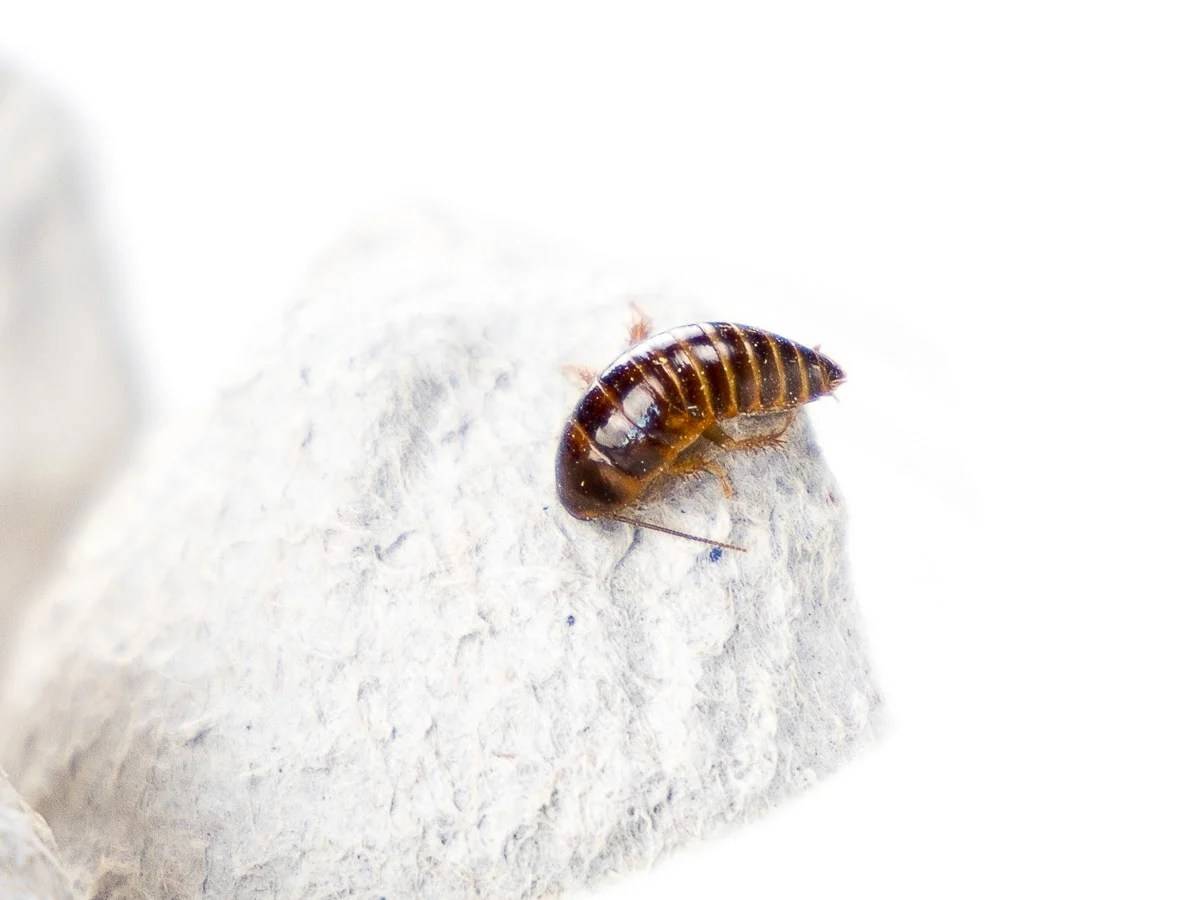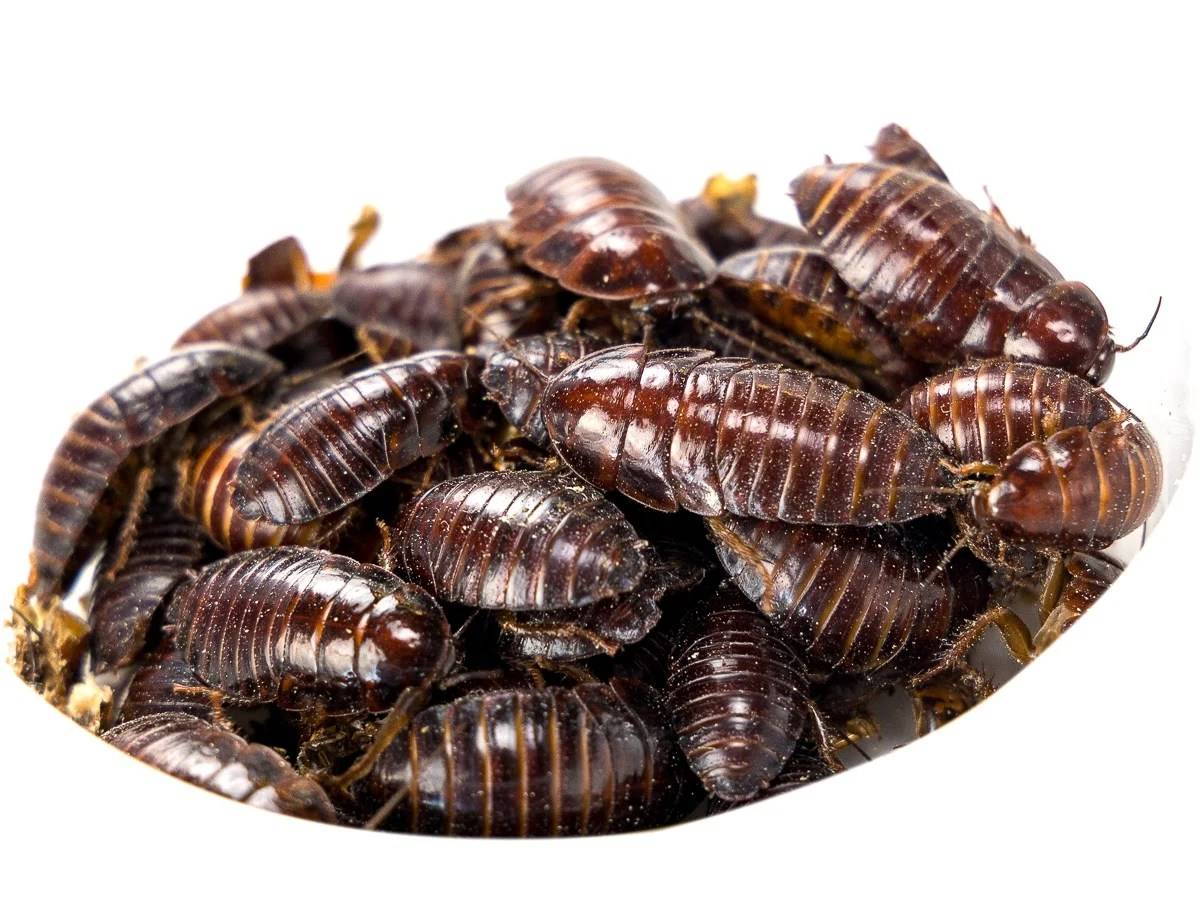Josh's Frogs
Orange Head Roach

By Nadja Tarabara and Kayla Luebbert
Intro
Orange Head roaches (Eublaberus posticus) are liked for their ease of care, hardiness, fast reproductive rate, nutritional value, and size range. Some consider Orange Heads to be one of the most beautiful species of cockroach. Known for their bright orange color and large size, they tend to be a bit meatier than Dubia roaches with adults growing up to 2 inches in length. Orange Head nymphs are a dark red color, and can be found burrowing into the substrate. Additionally, Orange Head roaches do not make noise, a pleasant bonus when compared to the traditional feeder insect, the cricket. Josh’s Frogs sells Orange Head roaches in several different sizes and quantities - Check out Orange Head roaches for sale today!
Natural History
Orange Head roaches are naturally found in Central and South America. Wild populations can be found in cave systems, with adults and older nymphs populating the lower cave walls. Younger nymphs prefer to burrow.
Orange Heads are live-bearing, cannot fly, and cannot climb smooth surfaces. Given proper care, Orange Heads can grow larger than dubia with adults measuring 1-2”. Unlike Blaptica dubia roaches, Orange Heads emit a defensive odor when disturbed.
Habitat
Here at Josh’s Frogs, we keep our Orange Head roaches in 80 quart Sterilite brand plastic tubs. Darker tubs will allow your roaches to remain active 24/7, resulting in faster growth and reproduction. Proper ventilation is a must, and can be achieved by either drilling or cutting holes in the sides or top of your container. The holes can be covered with mesh to keep invaders out, and to keep roaches in. While Orange Head roaches cannot climb smooth surfaces, it is still a good idea to cover ventilation holes with mesh for added security. We recommend the “Mesh Utility Fabric” sold at Joann’s Fabric stores.
For many hobbyists, heat is provided by a 150w ceramic heat emitter positioned above the colony. Keeping Orange Head roaches warm is important, as the warmer Orange Head roaches are kept, the faster Orange Head roaches will reproduce. They will be fine at room temperature, but up to 90° F is ideal. At Josh’s Frogs, we utilize the waste heat from our building’s electrical transformers to heat our roach rooms to a balmy 85° F.
Humidity
High humidity is also important, which can be provided by using a substrate of 2 inches of coco bedding that is routinely watered. We recommend keeping orange head cockroaches at 50%+ humidity if at all possible. Mist several times a week to help maintain humidity. If humidity is lower than 50%, make sure to provide a lot of moisture in their diet.
You do not want the Orange Head colony to be soaking wet, but you don't want it to be dry, either. Substrate is not absolutely necessary, but many find it’s easier to maintain proper humidity levels that way. In addition, nymphs enjoy burrowing into the substrate. We do not utilize substrate with our Orange Heads, as it makes collection more difficult. Instead, we rely on water gel crystals for moisture. There will be more about water gel crystals in the “Feeding” section.
Other considerations
Cardboard Egg Crate provides places for Orange Head roaches to hide and give birth. Adult Orange Heads will spend most of their time hiding in the egg crate, while nymphs will burrow into the substrate. The egg crate can be positioned vertically or horizontally. At Josh’s Frogs, we place the egg crate vertically, so most waste falls to the bottom of the bin. Excess debris can be cleared from the egg crate by gentle shaking. Orange Head roaches tend to cling to the egg crate when it is picked up. They can be removed by shaking. Larger Orange Head roaches tend to fall off sooner than smaller nymphs, and can be sorted by size in this manner.
Orange Head roach colonies may need to be cleaned every 3-4 months. At Josh’s Frogs, we recommend seeding the substrate of Orange Head roach colonies with springtails, a small soil isopod that breaks down organics. This significantly reduces the chance that mold will grow in the Orange Head roach colony, which can kill your roaches. Most of the substrate should be changed in Orange Head roach colonies every 3-4 months.

Feeding
Orange Head roaches are not too picky about their diet. We routinely feed them fresh fruits such as apples and oranges. Fruits are beneficial to the roaches by providing many essential nutrients to keep them healthy and strong, and will also supply the same benefits to the animals you feed them to.
For those looking to breed your own roaches, oranges have been shown to act as an aphrodisiac, which will ramp up production. However, due to the acidic nature of oranges, they should not be given to your roaches everyday or as the only food source. High levels of acidity can harm the animal you are feeding them to.
We also feed our Orange Head roaches a special diet that we formulate and make ourselves, Josh’s Frogs Roach Diet. Several years in the making, Josh’s Frogs Roach Rations provides proper levels of protein and other nutrients essential to the health and growth of a Orange Head roach culture. Josh’s Frogs Roach Diet also functions as a gut load for Orange Head roaches, rendering them much more nutritious than Orange Head roaches that are fed lower quality diets.
Wing Biting
Orange Head roaches will eat just about anything. Since they are more carnivorous than other species of roaches, such as Blaptica dubia roaches, they are more prone to wing biting. If not provided with high protein food, they will eat the wings of other fellow roaches in the colony. This does not affect the breeding of the colony and is only cosmetic. To give them the protein they so dearly crave, we provide our Orange Head roaches with high protein dry cat food on occasion. They love it!
Orange Head roaches also need to be provided with a source of moisture. At Josh’s Frogs, we use our Insect Watering Gel (use Calci-mMm Insect Watering Gel if you’ll be feeding the roaches to an animal) to provide water to our Orange Head roaches. Polymer crystals are by far the easiest and most convenient way to provide moisture to your Orange Head roaches. They are inexpensive, easily stored, and made ready for use. They also do not go bad, unlike fruits and vegetables. Using watering gel also ensures that baby roaches cannot drown in their water dish. Along with a high protein diet, keeping a constant water source in the colony will help decrease wing biting.
Reproduction
An Orange Head roach starts life as ¼” nymph (baby roach). Under proper conditions, the roaches will become sexually mature adults in 3-4 months and will be 1-2” in size. Once they become mature, just put a male and female together and eventually you’ll see baby Orange Head roaches!
Females carry their ootheca (egg case) internally for 30 days to allow the babies to develop. After that time, 20-40 babies will be born. After they are born, the female tends to stay in close contact with her nymphs for about a week to look after her newly born, vulnerable babies. This connection helps the babies to thrive, so it's important not to separate them during this time.
Females can give birth every month throughout their 2-3 year life span, so you’ll quickly have a colony with a wide range of sizes. To induce breeding in Orange Head roaches, make sure to keep their colony between 80-90° F. Feeding them oranges is also a great way to increase reproduction. As long as they are well fed and housed properly, they'll quickly make more of themselves!

Permits and Legality
Many people do not realize that all roach species, with the exception of the hissing roaches, are classified as crop pests by the USDA. Because of this, interstate transport is illegal unless the proper permits are in place. Josh’s Frogs has the proper USDA permits to legally ship Orange Head roaches across state lines. We’ve done the legwork and can ship Orange Head roaches to all US states except Florida. As long as you don't live in Florida, you can legally order and receive Orange Head roaches from Josh’s Frogs. A copy of the relevant permits is available via email upon ordering.
We partnered with the USDA to create a handout informing any insect/animal/plant purchasers to not release organisms into the wild, and how to dispose of them properly. This informative flier is included free with every Orange Head roach purchase.
Environment
Pets, plants, and insects can be dangerous when released outside, and should NEVER BE RELEASED INTO THE ENVIRONMENT. Doing so can be illegal and can be very harmful to your native wildlife. Make sure to always rehome your animals if you find yourself unable to care for them, and dispose of your plants and insects appropriately.
To protect your environment, follow these practices:
- Never release feeder insects outdoors
- To dispose of unwanted feeder insects, freeze the organisms (and all materials exposed to the organisms, such as bedding) for 3 days, then dispose of them in the trash
Follow the simple steps outlined above and protect the environment. Remember, keeping exotic animals is a privilege that must be protected. Be a responsible pet owner – it’s the ethical (and legal!) thing to do!
If you have any questions about the handling, keeping, or disposal of these organisms, please contact Josh’s Frogs or APHIS Plant Protection and Quarantine at (866)524-5421 or [email protected]. Another great source of information is PIJAC’s Habitattitude page.
